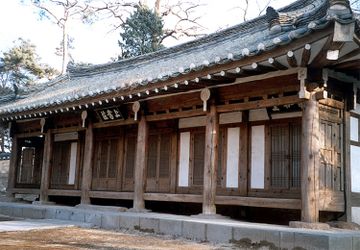상서장
| 상서장 Sangseojang Shrine |
|
 상서장, 국가문화유산포털, 문화재청. |
|
| 대표명칭 | 상서장 |
|---|---|
| 영문명칭 | Sangseojang Shrine |
| 한자 | 上書莊 |
| 주소 | 경북 경주시 서라벌대로 105-12, 외 임야 11필 (인왕동) |
| 지정(등록) 종목 | 경상북도 기념물 제46호 |
| 지정(등록)일 | 1984년 5월 21일 |
| 분류 | 유적건조물/인물사건/인물기념/사우 |
| 수량/면적 | 16,397㎡ |
| 웹사이트 | 상서장, 국가문화유산포털, 문화재청. |
|
|
|
해설문
국문
신라 말의 문신이자 대문장가인 고운 최치원(孤雲 崔致遠, 857~?)이 시무십조(時務十條)*를 쓴 곳이다.
최치원은 12세 때인 경문왕 8년(868)에 중국 당나라로 유학하여, 18세에 과거에 급제하였다. 헌강왕 11년(885) 귀국하여 어지러운 국정을 바로잡고자 애썼다. 특히 진성여왕 8년(894)에 시무십조를 여왕에게 올린 것으로 유명하다. 후에는 벼슬을 버리고 가야산, 지리산 등 명산을 찾아 자연과 벗 삼아 지내다가 해인사(海印寺)에서 여생을 마쳤다. 고려 현종 때 문창후(文昌侯)에 추봉되고, 공자묘에 배향하도록 했다. 이때 최치원이 머물며 공부하던 이곳을 임금에게 글을 올린 집이라는 뜻에서 상서장이라 부르기 시작했다.
현재 이곳에는 상서장과 영정각, 추모문 등이 있고 조선 고종 때 건립한 비가 남아있다. 최치원의 영정을 봉안하고 매년 4월 제사를 지낸다.
- 시무십조(時務十條): 최치원이 진성여왕에게 건의한 정책, 그 내용은 전해오지 않음.
영문
Sangseojang Shrine
This shrine is dedicated to Choe Chi-won (857-?), a well-known writer who lived at the end of the Silla period (57 BCE-935 CE). In 1874, a stele and pavilion was erected by the civil official Yi Don-sang (1815-?) to commemorate this place as the site where Choe once lived and studied. The other buildings in the current complex were built sometime after this, and include Sangseojang Hall, a portrait shrine, and a memorial gate. A memorial ritual is performed annually in April at the portrait shrine.
In 868, when Choe was just a boy, he went to study in Tang China. In 874, he placed first in the civil service examination for foreigners there and took an official post. In 879, when Huang Chao started a rebellion in China, Choe Chi-won wrote him a well-known manifesto, which made him widely famous as a skillful writer. Later in 885, he came back to Silla and tried to fix the chaotic political situation in the country. In 894, he wrote a proposal called Ten Urgent Points of Reform (Simusipjo**) to Queen Jinseong (r. 887-897), but it was eventually rejected due to the opposition of the ruling class. Disappointed, he retired from his official post and lived in seclusion, enjoying the nature and travelling through sacred mountains, such as Gayasan and Jirisan, until he finally settled at Haeinsa Temple in Hapcheon where he spent his last years.
This hall was named Sangseojang meaning “the house where the letter to the Queen was written,” because it is said that Choe Chi-won wrote Ten Urgent Points of Reform at this place.
- 건물들에 대한 역사 성멸이 없어서 아래 링크 참조하여 수정했어요.
- On the internet I could only find it under the name 시무여십조, not 시무십조
영문 해설 내용
신라 말의 문장가 최치원(857~?)이 머물며 공부하던 곳이다. 현재 최치원이 공부하던 상서장, 영정각, 추모문 등의 건물과 1874년에 세워진 비석이 남아있으며, 영정각에 최치원의 영정을 모셔놓고 매년 4월 제사를 지낸다.
최치원은 868년 당나라로 유학을 떠났으며, 874년 당나라에서 치른 과거에서 장원 급제하였다. 이후 당의 관직을 지내던 중, 879년 민란을 일으킨 황소(黃巢)에게 보낸 격문으로 문장가로서 이름을 떨쳤다. 885년 신라로 돌아와 어지러운 정치를 바로잡고자 힘썼다. 특히 894년 "시무십조"라는 개혁안을 진성여왕(재위 887-897)에게 건의하였으나, 당시 집권세력의 반발로 개혁안은 실현되지 못했다. 좌절한 최치원은 관직을 버리고 가야산, 지리산 등 명산을 찾아 자연과 벗 삼아 지내다가 합천 해인사에서 여생을 마쳤다고 한다.
이곳은 최치원이 시무십조를 썼던 곳이라고도 전해진다. ‘상서장’이라는 이름은 ‘왕에게 글을 올린 집’이라는 뜻이다.